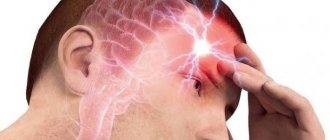Diseases associated with a lack of cerebral blood supply are common. The appearance of ischemia and, as a consequence, stroke, is observed in an increasing number of people at any age. Children are also susceptible to this. Typically, diagnosis is carried out after a special test in the maternity hospital. During the procedure, you need to assess the child’s condition using the Apgar scale. The study is mandatory for newborns. But a full diagnosis is possible only after a series of procedures.
Grade 1 cerebral ischemia in a newborn is a neurological disease associated with a lack of oxygen supply to the brain. Otherwise called HIE (hypoxic-ischemic encephalopathy) and often leads to disability in children. The diagnosis of cerebral ischemia in a child is one of the most complex pathologies in the neurological field.
Classification of pathology
According to the time of appearance there are:
- Ischemia of the central nervous system in newborns, which appears during embryonic and natal development. Clinical signs appear in the first few days of life. In 70% of cases, the appearance of symptoms is observed during childbirth or gestation, especially characteristic in the last stages.
- The chronic type appears in adults and older people. It occurs especially often among pensioners. May lead to ischemic stroke.
Ischemic diseases of newborns are divided into 3 stages. Hypoxic-ischemic encephalopathy grade 1 is the mildest form of neurological disease of the central nervous system. It is characterized by mild symptoms that appear 3-5 days after birth.
The most characteristic manifestations:
- severe nervous excitement or depression;
- the muscular system is constantly tense;
- tendon reflexes are strengthened.
With this form, it is not necessary to place the patient in a hospital. The disease goes away with time.
Cerebral ischemia of the 2nd degree in a newborn manifests itself in the first day of the child’s life. Symptoms usually appear within a month. Obligatory requirement is supervision by a doctor. During your stay in the hospital, therapeutic measures are required. If the pathological condition of the central nervous system is caused by blockage of blood vessels with a blood clot, surgical intervention may be required.
Hypoxic-ischemic encephalopathy grade 3 in newborns is considered the most severe. Characteristic manifestations:
- lack of reflex activity;
- coma;
- problems with heart rhythm;
- severe hypertension;
- impossibility of normal functioning of the respiratory system;
- problems with oculomotor function.
Upon consultation with a specialist, the presence of severe symptoms can be determined within a few minutes after birth. The patient is necessarily sent to intensive care. If the baby has problems with independent breathing, then connection to an artificial life support apparatus is required. The phenomena are often observed in prematurity.
Causes of cerebral ischemia
Cerebral ischemia can occur due to various factors. Again, if you believe the statistics, the cause of this disease may even be the mother’s age.
For example, it has been found that most often ischemia can be detected:
- in women who gave birth before 20 years of age;
- in women who gave birth after 35 years.
This is due to impaired blood circulation in the placenta.
Also, the threat can be identified in those women who suffer from chronic diseases, most often these are:
- diabetes;
- vascular hypertension.
However, even healthy women who do not fall into statistically dangerous age categories can be susceptible to this disease (as a result of which the newborn will be diagnosed with “cerebral ischemia”).
The reasons may be:
- manifestation of toxicosis in the last months of pregnancy;
- twins, triplets (multiple pregnancy);
- frequent changes in blood pressure (especially increases);
- post-term baby (the fetus risks not receiving enough nutrition from the mother in the womb);
- premature baby;
- entwining the baby with the umbilical cord (regardless of when this phenomenon occurred: during pregnancy or during childbirth);
- rapid birth (birth of a child in less than 6 or 4 hours in primiparas and multiparas, respectively);
- long labor (here ischemia is caused due to hypoxia or asphyxia).
Causes of the disease
Cerebral ischemia in a child is not considered an independent pathological condition. Most often these are consequences of cerebral hypoxia. With the development of oxygen deficiency, the rate of metabolic processes decreases significantly and starvation of the nervous tissue occurs. Neurons are unable to remain without oxygen for a long time. In this case, problems and various disorders are observed. As a result, the death of nerve cells and the development of tissue necrosis begins. The phenomena lead to a deterioration in the functional activity of the brain. Moreover, the less oxygen access to the organ, the more severe the patient’s condition.
Symptoms of cerebral ischemia
Attentive parents may notice strange behavior in their newborn. Any suspicion should alert the mother (and we are not just talking about cerebral ischemia). If you see that your baby looks a little strange or his actions make you think, call your doctor.
Signs of brain damage (or encephalopathy, in medical terminology) can also manifest themselves in a newborn in different ways:
- the child has noticed an enlargement of the fontanelle and head (that is, hydrocephalus is present);
- the newborn has signs of tremor of the chin and other parts of the body (arms, legs, lips);
- the baby is too excitable, often cries and screams without reason, sleeps restlessly;
- the child’s face is somewhat asymmetrical;
- the baby behaves “inhibited”, has difficulty latching on to the mother’s breast, cannot feed normally, and has difficulty swallowing;
- strabismus is noticed behind the baby;
- the baby shudders for no good reason, the arms and legs are seized with convulsions (they can cause fainting - most often this is characteristic of stage II ischemia).
Sometimes the symptoms of cerebral ischemia occur as if they belong to a completely different disease.
Before treating your baby, you need to make a correct diagnosis.
Clinical manifestations
Symptoms of the disease vary significantly at different stages. And if the first degree does not require placing the child in a hospital and the signs disappear within a few days after the disease, then the second and third require close attention from doctors and, if necessary, resuscitation measures.
Symptoms of CI 1st degree
The pathological condition is characterized by mild damage to the tissues of the central nervous system, followed by the development of oxygen starvation. The cause of the disease is usually difficult childbirth with injuries and asphyxia. Symptoms are mild. Therefore, it is difficult to determine the presence of the disease. Because of this, adverse consequences may develop.
The most typical manifestations are:
- Severe headaches and migraines. They manifest themselves in the form of restless behavior, sleep problems and tension. The baby will cry often.
- Increased muscle tone is possible. The muscular system is constantly tense. Dense when touched with fingers. The degree of hypertonicity is determined by a specialist, since muscle tension is normal for infants.
- Increased response to tendon reflexes. Information is collected by tapping the knee joint with your fingers. In this case, the limb bends very quickly.
Diagnosis and treatment of disease in infants
Diagnosis of cerebral ischemia in a newborn is carried out after the following examinations:
- Complete blood count (erythrocyte count and leukocyte formula).
- Urinalysis (protein content, leukocytes).
- Neurosonography is an ultrasound examination of the skull through the fontanelles, searching for asymmetrical parts of the brain, enlarged cavities and spaces, and formations.
- Ultrasound examination of blood vessels using Doppler methods. Additionally, acceleration or deceleration of blood flow through the main vessels is detected.
- EEG, which detects changes in the activity of the brain.
- Magnetic resonance imaging is rarely used due to the need for anesthesia. It is used only in cases of suspected brain developmental defects.
- Computed tomography, which is used if bleeding into the cranial cavity is possible.
The treatment method is chosen by the doctor based on the patient’s condition. In the acute period, methods are aimed at supporting life and include:
- artificial air circulation;
- maintaining blood salt balance;
- drugs against involuntary muscle contractions.
After the end of the acute period, the following groups of drugs are used:
- improving blood flow through vessels and intracellular metabolism.
- diuretics that lower blood pressure;
- restoration of the balance of metal ions;
- nootropics to improve the functioning of the central nervous system.
Also used:
- massage therapy;
- gymnastics;
- hydrotherapy;
- complex of physiotherapeutic measures.
Preventive actions
Methods for preventing cerebral ischemia concern the mother of the child.
Activities include:
- increasing time spent in fresh air;
- getting rid of bad habits;
- avoiding stress and fatigue;
- adherence to the regime and consumption of foods containing vitamins;
- no need to overload the body with loads;
- monitor blood pressure;
- control the level of respiratory pigment;
- prevent obesity;
- prevent infections.
Complications and consequences
The development of cerebral ischemia in newborns causes oxygen deficiency-induced damage to its cells and causes very serious, often irreversible neurological consequences and complications that are correlated with the topography of the lesions.
Studies have shown that cerebral ischemia in newborns is more susceptible to pyramidal cells of the hippocampus, Purkinje cells in the cerebellum, reticular neurons of the perirolandic region of the cerebral cortex and the ventrolateral part of the thalamus, cells of the basal ganglia, nerve fibers of the corticospinal tract, midbrain nuclei, as well as neurons of the neocortex and brainstem brain
In full-term newborns, the cerebral cortex and deep nuclei are primarily affected; in premature newborns, diffuse destruction of the white matter cells of the hemispheres is noted, which causes chronic disability in surviving children.
And with global ischemia of brain stem cells (in which the centers for regulating respiration and heart function are concentrated), their total death and almost inevitable death occurs.
Negative consequences and complications of perinatal and neonatal cerebral ischemia of 2-3 degrees in young children are manifested by epilepsy, unilateral vision loss, delayed psychomotor development, motor and cognitive disorders, including cerebral palsy. In many cases, their severity can be fully assessed by the child’s age of three.
- Cerebral ischemia grade 1 in a newborn - causes, symptoms and treatment
[45], [46]
Consequences of brain ischemia in children
Complications and consequences of cerebral ischemia in newborns are also distinguished by stages. With a mild course of the disease, changes are invisible. There may be no negative effects. There is no impact on development. With timely initiation of treatment, sleep problems, headaches, and epilepsy are possible.
The consequences of grade 2 cerebral ischemia in newborns can cause the following complications:
- Up to 10% of patients experience disturbances in the functioning of the cardiovascular system associated with surges in blood pressure.
- Up to 50% of patients have developmental disorders.
The first degree is considered safe for the baby. Possible slow growth or hyperactivity.
In the third degree, changes affect a specific part of the brain. Therefore, it depends on the department that was affected by the pathological condition. The patient remains paralyzed or dies. If you start treatment on time, the risk of irreparable changes is reduced.
Forecast:
- Up to 50% of patients die within a few days from infectious diseases.
- Mental development disorders, dementia, autism and others are possible.
- Up to 10% of patients remain with changes in mental development.
Children who have had ischemia are included in the risk group for diseases of the cardiovascular system and stroke.
Causes of development of chronic cerebral ischemia
The causes of the development of chronic cerebral ischemia are closely related to atherosclerotic stenosis, thrombosis, and embolism. A certain role is played by post-traumatic dissection of the vertebral arteries, extravasal (extravascular) compression due to pathology of the spine or neck muscles, deformation of the arteries with constant or periodic disturbances in their patency, and hemorheological changes in the blood. It must be borne in mind that symptoms similar to those that occur with chronic ischemia can be caused not only by vascular, but also by other factors - chronic infection, neuroses, allergic conditions, malignant tumors and other reasons with which a differential diagnosis should be made .
Signs of impaired cerebral blood flow are observed in the following diseases:
- hypertension,
- atherosclerosis,
- hypotension,
- vasculitis (inflammation of blood vessels) of allergic and infectious etiology,
- thromboangiitis obliterans,
- skull injuries,
- abnormalities of the cerebral vascular bed and aneurysms,
- disturbances in cardiac activity,
- blood diseases,
- endocrine pathology,
- kidney diseases and other diseases.
The development of chronic cerebral ischemia is promoted by a number of reasons, which are commonly called risk factors. Risk factors are divided into correctable and non-correctable. Uncorrectable factors include old age, gender, and hereditary predisposition. It is known, for example, that a stroke or encephalopathy in parents increases the likelihood of vascular diseases in children. These factors cannot be influenced, but they help to identify in advance those at increased risk of developing vascular pathology and help prevent the development of the disease. The main correctable factors in the development of chronic ischemia are atherosclerosis and hypertension. Diabetes mellitus, smoking, alcohol, obesity, insufficient physical activity, poor nutrition are the reasons that lead to the progression of atherosclerosis and the deterioration of the patient’s condition. In these cases, the blood coagulation and anticoagulation system is disrupted, and the development of atherosclerotic plaques is accelerated. Due to this, the lumen of the artery is reduced or completely blocked. At the same time, the crisis course of hypertension is especially dangerous: it leads to an increase in the load on the blood vessels of the brain.










